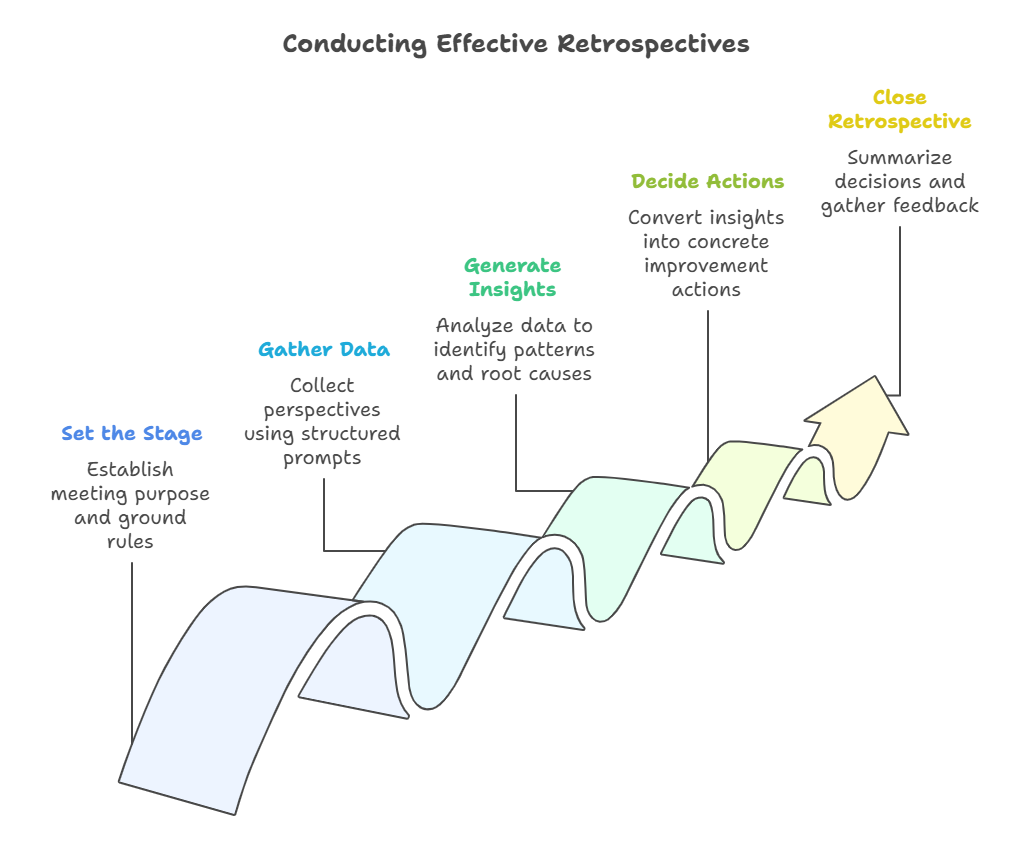How to Conduct a Product Retrospective: A Practical Guide
Learn how to run effective product retrospectives with actionable frameworks, agenda templates, and best practices for continuous improvement.
What is a Product Retrospective
A product retrospective is a structured meeting where teams reflect on recent work, identify successes and challenges, and plan improvements for future cycles. As defined by CareerFoundry, it's a scrum ceremony where teams reflect on the process, identify what went well and less well, and determine how to improve.
Unlike status updates or planning sessions, retrospectives focus specifically on process improvement and team dynamics. They create a safe space for honest feedback and collective learning, making them essential for agile teams seeking continuous improvement.
Why Product Retrospectives Matter
Regular retrospectives transform how teams work together and deliver value. They provide several critical benefits:
- Continuous improvement: Teams systematically identify and address process bottlenecks
- Team alignment: Everyone gains shared understanding of what's working and what needs change
- Psychological safety: Structured formats encourage open communication without blame
- Data-driven decisions: Retrospectives turn subjective experiences into actionable insights
Preparing for Your Retrospective
Effective preparation sets the stage for a productive session. According to UserVoice, you should plan ahead, send out an outline, use an agenda with key questions, and agree on action items to make a launch retrospective productive.
Key preparation steps include:
- Define the scope: Determine what period or project you're reviewing
- Gather data: Collect relevant metrics, feedback, and observations
- Set the agenda: Structure the conversation around specific themes or questions
- Choose a facilitator: Designate someone to guide the discussion neutrally
The Retrospective Agenda Framework
A well-structured agenda keeps the conversation focused and productive. Based on Reddit discussions, effective retrospectives typically gather everyone, show the agenda, announce the topics, let people join a topic they would like to discuss across teams.

Set the Stage (5-10 minutes)
Begin by establishing the meeting purpose and creating a safe environment. Review the retrospective's goal and any ground rules for constructive discussion.
Gather Data (15-20 minutes)
Collect perspectives using structured prompts. As ProductSchool suggests, mention key facts, such as what the plan was, how it was followed, and what the outcomes were. This brings everyone onto the same page and provides context for the discussion.
Common data gathering techniques include:
- Start/Stop/Continue: What should we start doing, stop doing, or continue doing?
- Mad/Sad/Glad: Emotional reactions to recent work
- Four Ls: Liked, Learned, Lacked, Longed for
Generate Insights (15-20 minutes)
Analyze the collected data to identify patterns and root causes. Look for recurring themes rather than isolated incidents. Ask "why" multiple times to uncover underlying issues.
Decide Actions (10-15 minutes)
Convert insights into concrete improvement actions. Each action should have a clear owner and timeline. Focus on 1-3 high-impact changes rather than numerous small tweaks.
Close the Retrospective (5 minutes)
Summarize decisions, confirm action items, and gather feedback on the retrospective process itself.
Common Retrospective Pitfalls to Avoid
Even well-intentioned retrospectives can become unproductive without proper facilitation. Watch out for these common challenges:
- Blame culture: Focus on processes and systems, not individuals
- Action paralysis: Generating insights without committing to changes
- Dominant voices: Ensure all team members contribute equally
- Rushed decisions: Allow sufficient time for meaningful discussion
Making Retrospectives Actionable
The true value of retrospectives comes from implementing the identified improvements. Product Teacher emphasizes that effective retrospectives provide ideas for implementing impactful retros that drive real change.
To ensure your retrospectives lead to action:
- Assign clear owners: Each action item needs someone responsible for implementation
- Set specific deadlines: Define when changes should be implemented
- Follow up: Review previous action items at the start of each retrospective
- Measure impact: Track whether changes actually improve team performance
Visualizing Your Retrospective with Mind Maps
Complex retrospective discussions benefit from visual organization. Using a mind map can help teams structure their thoughts, identify connections between different issues, and ensure all perspectives are captured.
Mind mapping works particularly well for:
- Brainstorming sessions: Quickly capture diverse ideas without linear constraints
- Theme identification: Visually group related comments and observations
- Action planning: Map improvement ideas to specific process areas
- Progress tracking: Visualize how retrospective actions connect to larger goals
For teams looking to enhance their retrospective process, ClipMind's Project Planner provides structured templates that can be adapted for retrospective facilitation and action tracking.
Continuous Improvement Through Regular Practice
Product retrospectives become more effective with consistent practice. Schedule them regularly—after each sprint, major release, or project milestone. The rhythm of reflection and adjustment builds a culture of continuous learning and adaptation.
Remember that the goal isn't to have perfect retrospectives, but to create a sustainable practice of team reflection and improvement. Each session builds team trust and process maturity, ultimately leading to better products and happier teams.
 ClipMind
ClipMind